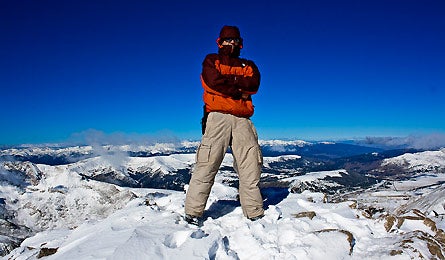Limit Pusher Skills

'Push your limits to reach the top. (by Erik Unger)'
Conquer Tough Terrain
Terrain extremes require specialized techniques. Learn these first.
Gorges/Canyons
Massive elevation changes result in huge temperature fluctuations, so pack layers for cold nights and rest in midday heat. Scramble safely: Only ascend slopes you can downclimb, maintain three points of contact (pack trekking poles, which also save knees), test holds, and don’t climb above others.
Deserts
Reduce heatstroke risk by wearing long, light-colored, breathable clothes; hiking early and late; and drinking one liter of water or energy drink every 60-90 minutes when temps approach triple digits.
Deep snow
Postholing will exhaust and dampen you (with sweat and snowmelt). Improvise snowshoes by tying 3-foot branches to your boots (stem-end forward). Travel in straight lines and walk single-file, taking turns breaking trail.
Jungles
Stay on paths (off-trail hiking may be impossible), and use a stick to part thorn-covered overgrowth. Use your machete sparingly; go around dense obstacles and look low for game trails.
Stay Fueled
Avoid bonking by consuming enough of the right foods on big days.
Calculate calories
Multiply your body weight by 21 and 25 (for moderate days), and 25 and 30 (for hard days) to estimate energy needs. For example, a 150-pound hiker will need between 3,750 (150 x 25) and 4,500 (150 x 30) calories on a hard day.
Consume strategically
Keep your mood and blood sugar steady by snacking (80 to 120 calories at a time) throughout the day. Munch within your first 90 minutes of hiking, and eat hourly. Store food in easy-access pockets, so you don’t have to stop.
Hydrate
Sip every 15 minutes (your body absorbs small amounts of liquid best). Add electrolyte mixes or take salt pills if you’re sweating excessively or develop cramps.
Prep for the Hike of Your Life
Going big? Push yourself with these muscle and mind-over-matter training tips.
LONGEST
Body: Increase weekly mileage and, two weeks pretrip, hike a long day (80 percent of your trip’s longest). Wear your planned footwear to toughen blister-prone skin.
Mind: Set short-term goals so you can celebrate regularly on-trail. Reward yourself (with a favorite snack or a short restbreak) after every success.
STEEPEST
Body: Boost cardio and quad strength by running hill repeats, up and down stairs, or by using a treadmill’s incline mode for 30 minutes two to three times a week.
Mind: Climbs may look bigger when you’re fatigued or grumpy. Stay energized (see below) and train your eyes on the terrain directly in front of you, not a hill’s apex.
HIGHEST
Body: Improve balance and descent-control with twice-weekly ab and lower-body strength training. Include squats, stepups, and walking lunges (with a pack).
Mind: Altitude can zap appetite, drive, and judgment. Set a schedule to stay on track: Eat and drink hourly, limit breaks to 10 minutes, plan a firm turn-around time.